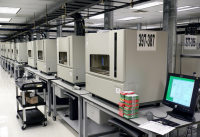








Automated DNA sequencer is a scientific instrument used to automate the DNA sequencing process. Given a sample of DNA, a DNA sequencer is used to determine the order of the four bases: G (guanine), C (cytosine), A (adenine) and T (thymine). This is then reported as a text string, called a read. Some DNA sequencers can be also considered optical instruments as they analyze light signals originating from fluorochromes attached to nucleotides.
The world’s first automated DNA sequencer was assembled by a team of researchers in Leroy Hood’s Caltech laboratory. The inventors on the patent for the prototype are Hood, Lloyd M. Smith, Tim J. Hunkapiller, and Michael W. Hunkapiller. A commercial version of the device was engineered by Applied Biosystems (ABI) of Foster City, California, and introduced to the marketplace in 1986.
The ABI sequencers employed an innovative fluorescence chemistry to distinguish the components of the genetic code. Each of the nucleotide bases in the DNA molecule (adenine, tyrosine, guanine, and cytosine) were tagged with and distinguished by a corresponding fluorescent dye. This innovation made it possible for sequences to be read rapidly by the machine. The machine’s introduction to the marketplace had a major impact. Scientists and policymakers had previously approached the idea of sequencing the entire human genome as a theoretical future possibility. With the invention of high-throughput automated sequencing, however, sequencing the human genome became a technologically viable endeavor.